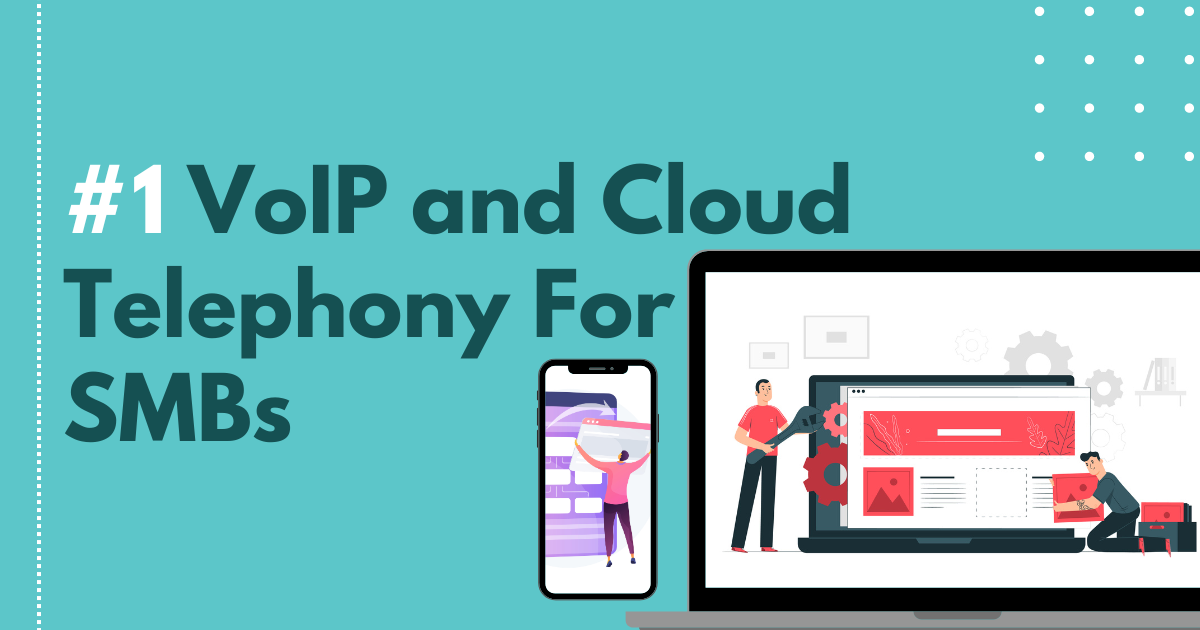Hey there, fellow tech enthusiasts and business aficionados! Today, we’re diving into the world of Voice over Internet Protocol (VoIP) and cloud telephony, two cutting-edge technologies that are reshaping the way small and medium-sized businesses (SMBs) communicate.
Gone are the days of bulky, expensive phone systems tethered to your office walls. With VoIP and cloud telephony services, your business can enjoy crystal-clear calls, seamless scalability, and cost-effective communication solutions that adapt to your needs, whether you’re a budding startup or a thriving SMB.
In today’s digital age, communication as a service lies at the heart of every successful business operation. As technology continues to advance, traditional phone systems are being replaced by more efficient and cost-effective VoIP solutions. Two such innovations are Voice over Internet Protocol (VoIP) and cloud telephony.
VoIP is a technology that allows users to make voice calls using a broadband Internet connection instead of a regular (or analog) phone line. This is achieved by converting voice signals into digital signals that can be transmitted over the Internet. On the other hand, cloud telephony refers to the delivery of telephone services over the Internet through cloud computing. It eliminates the need for physical infrastructure, such as phone lines and hardware, by leveraging the power of the cloud.
Now, you might be wondering, “How can VoIP and cloud telephony services benefit my small or medium-sized business (SMB)?” Well, buckle up, because we’re about to dive into a world of possibilities that these technologies can unlock for your business. From cost savings to enhanced features, VoIP and cloud telephony works to revolutionize the way SMBs communicate. Let’s explore some of the key benefits in more detail.
Join us as we explore the ins and outs of VoIP and cloud telephony, uncovering how these innovative technologies are ringing in success for SMBs everywhere.
The Evolution of Business Communication
Gone are the days of clunky desk phones and tangled wires dictating how businesses communicate. With the advent of VoIP and cloud telephony, the landscape of business communication as a service has undergone a remarkable transformation. Let’s take a closer look at how traditional phone systems stack up against these innovative technologies and the advantages they offer to SMBs.
Traditional Phone Systems:
- Reliant on physical infrastructure: Traditional phone systems require the installation of phone lines and hardware, which can be costly and time-consuming.
- Limited scalability: Adding new phone lines or features to a traditional system can be complex and expensive, making it challenging for SMBs to adapt to the changing business phone systems environment.
- High maintenance costs: Maintenance and repairs for traditional phone systems can be a significant expense, especially as hardware ages and requires updates.
VoIP and Cloud Telephony:
- Cost-effective: VoIP and cloud telephony services eliminate the need for costly hardware and infrastructure, as calls are made over the Internet.
- Scalability: With VoIP and cloud telephony solution, adding new lines or features is as simple as a few clicks, allowing SMBs to scale their communication systems effortlessly.
- Flexibility: VoIP and cloud telephony works in a way that offers a range of features, such as voicemail-to-email transcription, virtual receptionists, and call forwarding, instant messaging, that enhance communication and productivity.
- Accessibility: Cloud-based systems can be accessed from anywhere with an Internet connection, making remote work and collaboration more seamless than ever.
VoIP and cloud telephone solutions represent a quantum leap forward in business communication, offering SMBs a cost-effective, scalable, and feature-rich alternative to traditional phone systems. As technology continues to evolve, embracing these innovations can give SMBs a competitive edge in today’s fast-paced business environment.
Cost Savings and Scalability
One of the most appealing aspects of VoIP and cloud telephony solution for small and medium-sized businesses (SMBs) is the significant cost savings they offer compared to traditional phone systems. Let’s explore how these technologies can help SMBs save money and scale their communication systems to meet their growing needs.
Reduced Hardware and Maintenance Costs: Traditional phone systems require expensive hardware installations and regular maintenance to keep them running smoothly. In contrast, VoIP and cloud telephony operate over the Internet, eliminating the need for costly hardware and maintenance. This can result in substantial cost savings for SMBs, especially those operating on tight budgets.
Scalability to Meet Growing Business Needs: As SMBs grow and expand, so do their communication needs. VoIP and cloud telephony solutions offer unparalleled scalability, allowing businesses to easily add new lines or features as needed. Whether you’re adding new employees or opening new locations, VoIP and cloud telephony can scale to meet your growing business needs without the hassle and expense of upgrading traditional phone systems.
Cost savings and scalability offered by VoIP and cloud telephony make them a smart choice for SMBs looking to streamline their communication systems and reduce costs. By making the switch to VoIP and cloud telephony, SMBs can enjoy a reliable, feature-rich communication solution that grows with their business.
Enhanced Features and Flexibility
VoIP and cloud telephony are not just about making and receiving calls; they offer a wealth of features that can enhance communication and productivity for small and medium-sized businesses (SMBs). Let’s take a look at some of the key features that make VoIP and cloud telephony stand out in terms of flexibility and functionality.
Voicemail-to-Email Transcription: One of the standout features of VoIP and cloud telephony is the ability to transcribe voicemail messages into text and send them to your email inbox. This feature not only saves time but also ensures that you never miss an important message, even when you’re away from your desk.
Virtual Receptionists and Auto-Attendants: SMBs can create a professional and streamlined calling experience for their customers with virtual receptionists and auto-attendants. These features can greet callers, provide menu options, and route calls to the appropriate department or extension, all without the need for a human operator.
Call Forwarding and Routing Options: VoIP and cloud telephony offer flexible call forwarding and routing options, allowing SMBs to customize how incoming calls are handled. Whether you’re looking to forward calls to a mobile device, route calls based on time of day, or create custom call routing rules, VoIP and cloud telephony give you the flexibility to manage your calls efficiently.
Here are some more features that make cloud telephony even more attractive.
- CRM Integration: Many cloud telephony systems offer integration with Customer Relationship Management (CRM) software, allowing businesses to streamline their customer interactions. This integration can provide agents with valuable customer information before they even pick up the phone, improving the overall customer experience.
- Advanced Call Routing: Cloud telephony systems offer advanced call routing options, such as skills-based routing and priority routing. Skills-based routing ensures that calls are directed to agents with the right skills to handle them, while priority routing allows businesses to prioritize calls based on certain criteria, such as VIP customers or urgent issues.
- Interactive Voice Response (IVR): IVR systems allow callers to interact with a computerized system through voice or keypad inputs. This can help businesses automate routine tasks, such as bill payments or appointment scheduling, and provide callers with quick and efficient service.
- Call Analytics: Cloud telephony systems often include call analytics features that provide businesses with valuable insights into their call performance. This can include metrics such as call volume, call duration, and wait times, helping businesses identify areas for improvement.
- Mobile Apps: Many cloud telephony providers offer mobile apps that allow employees to make and receive calls from their business number on their mobile device. This can be particularly useful for remote or mobile workers who need to stay connected while on the go.
- Voicemail-to-Text: Similar to voicemail-to-email transcription, voicemail-to-text converts voicemail messages into text format, allowing users to read their messages rather than listen to them. This can be useful for quickly scanning messages and prioritizing callbacks.
- Conference Calling: Cloud telephony systems often include built-in conference calling features, allowing businesses to conduct virtual meetings and video conferencing with multiple participants. This can be a cost-effective alternative to traditional conference calling services.
The enhanced features and flexibility of VoIP and cloud telephony make them an attractive option for SMBs looking to improve their communication systems. By leveraging these features, SMBs can create a professional and efficient calling experience for their customers and employees alike.
Improved Collaboration and Accessibility with Cloud Telephony
VoIP and cloud telephony offer small and medium-sized businesses (SMBs) the ability to collaborate more efficiently and stay connected from anywhere. Let’s explore how these technologies can improve collaboration and accessibility for SMBs.
Seamless Integration with Other Business Tools: One of the biggest advantages of VoIP is their ability to integrate seamlessly with other business tools, such as Customer Relationship Management (CRM) software. This integration allows SMBs to centralize their communication and customer data, providing a more holistic view of their operations and improving overall efficiency.
For example, when a customer calls, the system can automatically pull up their CRM record, giving the agent valuable information about the caller’s history and preferences. This not only improves the customer experience but also allows for more personalized interactions.
Mobile Apps for On-the-Go Communication: Another key feature of VoIP and cloud telephony is the availability of mobile apps that allow employees to stay connected from anywhere. Whether they’re working from home, on a business trip, or out in the field, employees can use these apps to make and receive calls, access voicemail, and collaborate with colleagues as if they were in the office.
This level of accessibility not only improves employee productivity but also allows SMBs to provide better customer service, as employees can respond to inquiries and resolve issues more quickly, regardless of their location. By integrating with other business tools and providing mobile apps for on-the-go communication, these technologies empower SMBs to work smarter, not harder, and ultimately drive business success.
Security and Reliability
When it comes to business communication, security and reliability are paramount. VoIP and cloud telephony offer small and medium-sized businesses (SMBs) robust security measures and reliable service to ensure their communication systems are always up and running. Let’s delve into how these technologies provide a secure and reliable communication solution for SMBs.
Encryption and Data Protection Measures: VoIP and cloud telephony providers implement strong encryption protocols to protect sensitive data transmitted over their networks. This ensures that voice calls, messages, and other communications are secure and protected from unauthorized access.
Additionally, cloud telephony systems often include data protection measures, such as regular backups and secure storage, to safeguard against data loss and ensure business continuity.
Redundancy and Failover Options for Uninterrupted Service: To ensure uninterrupted service, VoIP and cloud telephony providers offer redundancy and failover options. Redundancy involves duplicating critical components of the communication system to eliminate single points of failure. If one component fails, another takes over seamlessly, ensuring that the service remains uninterrupted.
Failover options provide additional protection by automatically routing traffic to alternative paths or servers in the event of a failure. This ensures that even in the event of a network outage or hardware failure, SMBs can continue to communicate without disruption.
VoIP and cloud telephony offer SMBs a secure and reliable communication solution. By implementing strong encryption and data protection measures, as well as redundancy and failover options, these technologies ensure that SMBs can communicate with confidence, knowing that their communication systems are protected and reliable.
Conclusion
VoIP and cloud telephony are more than just buzzwords in the world of business communication—they are transformative technologies that offer small and medium-sized businesses (SMBs) a wealth of benefits. From cost savings and scalability to enhanced features and flexibility, VoIP and cloud telephony are reshaping the way SMBs communicate and collaborate.
By embracing these technologies, SMBs can streamline their communication systems, reduce costs, and improve efficiency. The seamless integration with other business phone systems and the availability of mobile apps for on-the-go communication make VoIP and cloud telephony invaluable assets for SMBs looking to stay ahead in today’s competitive business landscape.
Furthermore, the security and reliability offered by VoIP and cloud telephony ensure that SMBs can communicate with confidence, knowing that their data is protected and their communication systems are always up and running.
In short, VoIP and cloud telephony are not just tools; they are enablers of business success. By leveraging these technologies, SMBs can unlock new opportunities for growth, improve collaboration, and provide better service to their customers. So, if you’re an SMB looking to take your communication systems to the next level, it’s time to ring in the changes with VoIP and cloud telephony.





Leave a reply